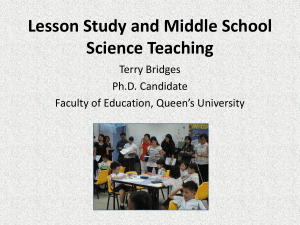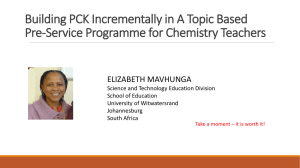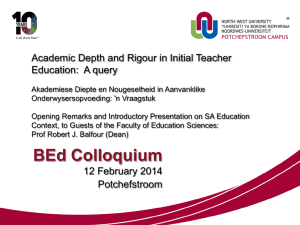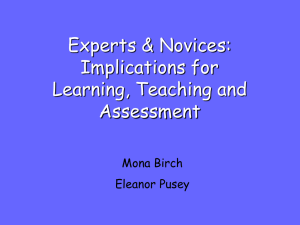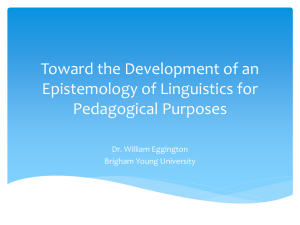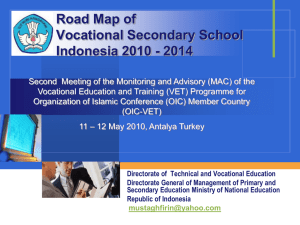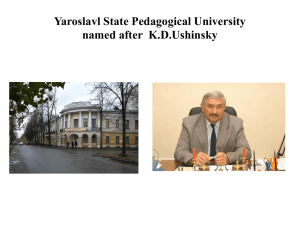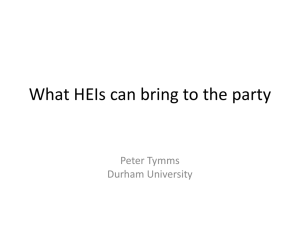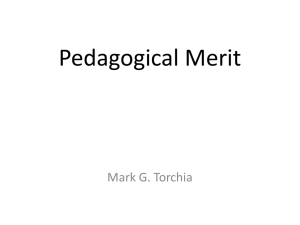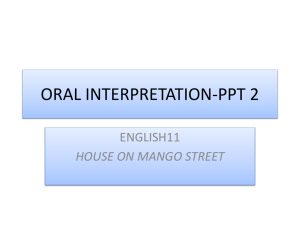Pre-service science teachers
advertisement
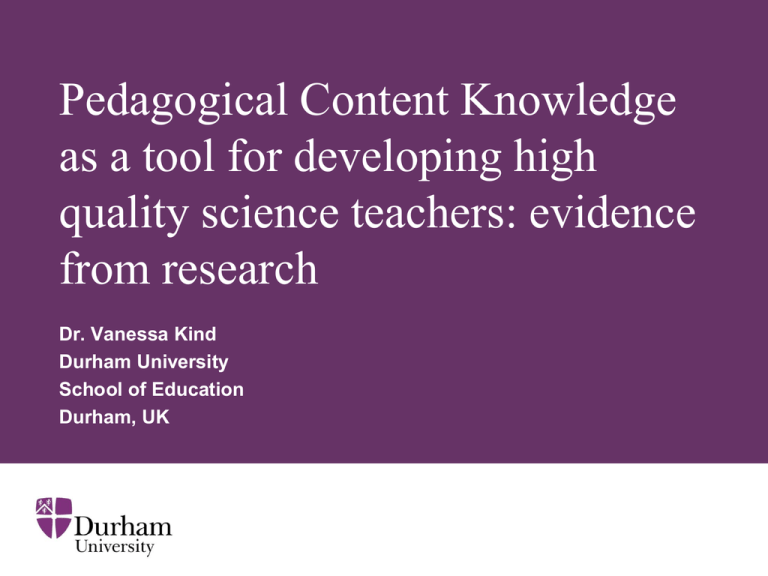
Pedagogical Content Knowledge as a tool for developing high quality science teachers: evidence from research Dr. Vanessa Kind Durham University School of Education Durham, UK Introduction • Pedagogical content knowledge (PCK) as a tool for studying teachers’ practices • PCK models • Research evidence – What is pre-service teachers’ PCK like? ∂ – What content knowledge do pre-service teachers have? – In what ways do content knowledge and PCK connect? • A revised model • Educating high quality science teachers Pedagogical Content Knowledge (PCK) as a tool for studying teachers’ practices Lee Shulman (1987) described “pedagogical content knowledge” as a “special amalgam” of knowledge possessed by a teacher ∂ PCK is… unique to teachers one component of teachers’ knowledge base Shulman suggested PCK comprises two components:Representations and/or Instructional strategies – what teachers “do” to teach: illustrations, analogies, explanations and demonstrations ∂ Knowledge of students’ subject-specific learning difficulties – misconceptions, naïve ideas, preconceptions and that subject matter knowledge, SMK, is transformed by a teacher for his/her students’ benefit. Other researchers propose PCK includes any or all of General pedagogical knowledge / classroom management Knowledge of curriculum ∂ School knowledge Knowledge of assessment Purposes / orientations/ Nature of science Socio-cultural issues Subject matter knowledge (SMK) Context for learning creating … A variety of PCK models, such as Grossman (1990) Magnusson et al (1999) Veal & MaKinster (1999) Representations Students’ understanding Knowledge of … ∂ Subject matter Curriculum Assessment Koballa Marks et al (1990) (1999) School / context / socio-cultural issues General pedagogy Purposes/ orientations Is subject matter knowledge “in” or “out”? “Out” Transformative “In” Integrative (Gess-Newsome, 1999) PCK is new knowledge created by the teacher to make his/her subject matter knowledge understandable Magnusson et al (1999) Grossman (1990) ∂ PCK represents everything a teacher knows / does Veal & MaKinster (1999) Koballa et al (1999) Marks (1990) PCK research – occurs in various settings and contexts around the world – adopts qualitative OR quantitative methodologies • If qualitative – triangulation and analysis are poor • If quantitative – correlations claim inappropriate ∂ cause and effect – adopts a PCK model as a background framework • selected BEFORE analysis of empirical evidence • selected model is ASSUMED to be correct – is often theoretical Unsurprisingly this results in – disagreement about what PCK is – what PCK offers ∂ – limited impact of research on practice of teacher education Consequences More prosaically, PCK is… Philosophically, PCK remains Alluring … promising … In the pre-science phase (Kuhn) ∂ A diverse set of research programmes (Lakatos) frustrating.. And / OR “Anything goes” (Feyerabend) Possibly leading us along…. Research evidence – start at the beginning • What is pre-service teachers’ PCK like? • What subject matter knowledge do pre-service ∂ teachers have? • In what ways do subject matter knowledge and PCK connect? Sample Pre-service teachers (PSTs) starting a one-year Postgraduate Certificate of Education (PGCE) teacher education program for teaching 11 -16s All PSTs:• are graduates in a science∂ subject • have 16+ qualifications in English, Maths and Science • have 18+ qualifications in at least one science subject • pass a “suitability for teaching” interview 235 PSTs from 2005 – 2010, 35 – 52 per year The pre-service teacher sample ∂ ∂ Most PSTs were well-qualified graduates aged 21 -25 Methodology This is a mixed methods study (Meriam & Associates, 2002) Data were collected by use of three vignettes and open-ended questions Classic content analysis (Ryan & Bernard, 2000) was ∂ applied to devise coding schemes for responses WARNING! No PCK model was assumed correct in the design of this study! Test: Does any evidence support a PCK model? The vignettes PSTs responded to one vignette each in chemistry, physics and biology Each:• described a teaching situation based on a teacher ∂ demonstration • listed main student misconceptions • stated the scientifically correct response • asked PSTs to “describe what you would do” to help students learn the correct answer Vignette: example A teacher showed a class of 11 -12 year olds magnesium burning in air. There was a bright white light, smoke, and white ash remained. Teacher asked, “Where did the ∂ white stuff come from?” •Responses included:Inside the magnesium It is carbon/ soot It is ash left over from burning •Correct answer: It was made in a reaction What would you do to help the class learn the correct answer? Biology and physics vignettes Biology Explanations for plant growth ∂ Physics Current flowing through an electric circuit Vignettes were analysed for evidence of: PCK ∂ SMK Connections between SMK and PCK Chemistry vignette initial PCK: Representations and Instructional Strategies Whole sample N=235 Chemists N=71 Biologists N=125 Physicists N=39 14 9 4 2 53 20 25 8 15 4 8 3 Show ash is MgO 10 3 6 1 Explanations Equation for reaction 39 16 19 4 Analogies “mixing paint” “baking a cake” 15 2 10 3 Illustrations Particle diagram 13 4 7 2 Use visual aids 16 3 9 4 Subcomponent Example Demonstrations Cut Mg Experiments Repeat experiment (variants) Do other reactions ∂ Chemistry vignette initial PCK: Knowledge of students’ understanding and orientations Component Sub-component Whole sample N=235 Chemists N=71 Biologist s N=125 Physicists N=39 Misconceptions 10 5 4 1 11 6 4 1 Didactic 123 39 67 17 Conceptual change 18 9 5 4 Academic rigour 18 5 10 3 Inquiry 8 2 5 1 Knowledge of students’ understanding Prior knowledge PSTs’ personal orientations ∂ Examples Talk about the magnesium – it is an element… explain the concept of conservation of mass .. (Didactic, Chemist) ∂ Most PSTs responded to their specialist vignettes using mainly didactic orientations. Explain the nature of electricity, it’s the flow of electrons illustrate how a light bulb works … (Didactic, Physicist) Explain that photosynthesis occurs in the leaves of plants to make food… (Didactic, Biologist) Examples Allow pupils to investigate with circuits and ammeters to see readings are the same, then give the correct explanation. Let students make and practice their own circuits changing it themselves… so they find out through practice.. (Chemist, Physics vignette, Guided Discovery) (Biologist, Physics vignette, Discovery) ∂ Allow pupils to grow their own plants from start, changing factors, then lead to the answer. (Physicist, Biology vignette, Activity Driven) PSTs responded to nonspecialist vignettes using a greater variety of orientations Chemistry vignette initial PCK responses: showed no evidence for General pedagogical knowledge / classroom management Knowledge of curriculum School knowledge ∂ Knowledge of assessment Socio-cultural issues Context for learning (of course, limitations apply) Chemistry vignette initial SMK: Content knowledge and substantive knowledge Component Whole sample N=235 Chemists N=71 Biologists N=125 Physicists N=39 23 4 18 1 22 7 12 3 Partially Mg burned correct 14 5 6 3 Incorrect Mg and O mix 6 0 5 1 Particle theory 14 5 6 3 Chemical reaction emphasised 16 3 8 5 Quality Correct Content knowledge – facts, concepts Substantive underpinning ideas Example New substance MgO ∂ Connections found between SMK and PCK Type Characteristics Transformative Correct content knowledge Factual content Analytical Dismantles misconceptions Transformative substantive Activities linked to substantive ∂ statement Aim to correct misconceptions Integrative No SMK statement Experimental detail Unrealistic experiment Transformative Incorrect content knowledge Misconception apparent SMK – PCK connection Transformative Correct content knowledge The white stuff is magnesium oxide Explain that the oxygen in the product comes from the air Say, “If I cut open the Mg strip∂will there be oxygen in there?” Mg strip only contains Mg atoms…so when it burns the product will contain Mg and atoms from the other reactant, oxygen Ash/ Soot comes from burning carbon containing species Correct SMK Instructional Strategy Academic orientation Students’ understanding Chemist, PhD, Female Transformative substantive …remind students about the definition of a chemical reaction. …get them to discuss what they think might be reacting with the magnesium, looking for “the air” or “oxygen”. Once established …link to this∂was the product of reacting magnesium and oxygen to make this new substance. I would return to their original answers to clarify which were correct and or the value in their answers. Substantive SMK Didactic orientation Students’ understanding Physicist, Masters degree, Male Integrative Weigh the magnesium before burning it. Collect the ash. The ash is weighed… an increase should be observed. Ask “Why did the weight∂ increase?” and “Where did the increase come from?” Repeat in nitrogen only. Ask, “Does it burn?” No …. No explicit SMK statement Didactic orientation Instructional strategy Industrial chemist, BSc degree, male Transformative Incorrect …demonstrate that product is a result of 2 reactants and all look different e.g. demonstrate with different colour paints, ∂ Red + blue -> purple Metal + gas -> white powder Didactic orientation Instructional strategy Incorrect SMK statement Biologist, MSc, female Findings (1) Pre-service teachers’ PCK comprises Representations and Instructional Strategies Knowledge of students’ understandings ONLY! ∂ Orientations tell / show / explain = didactic And tends to be transformative BUT PCK is hard to establish from written evidence Categories overlap with each other and there is evidence of “integrated” PCK We need a more accurate PCK model (2) Subject matter knowledge • Pre-service teachers’ subject matter knowledge :– is mainly content knowledge which is – correct – incorrect – partially correct ∂ • Quality is related to teachers’ subject specialist backgrounds • Shows some substantive knowledge based on “big ideas” We need to acknowledge quality differences (3) PCK – SMK connections • Good PCK is related to good quality, explicit SMK – Transformative correct – Transformative substantive • Poor PCK is related to poor / non-existent SMK – Transformative incorrect – Integrative ∂ • Evidence across all three vignettes indicated that subject specialists with the best quality SMK had the most appropriate PCK Non-specialists need support for SMK and PCK Subject matter knowledge My PCK model Knowledge of Students‘ Understanding Good PCK is characterized by Are mutually dependent ∂ Fast decision making Sequencing Effective planning for practice Knowledge of Representations and Instructional Strategies and produces Student learning Limitations and further research These findings are based on evidence from:– one group of PSTs from one institution – one data set comprising written evidence only – Vignettes which were limited in scope ∂ Confirmation is required, for example by:Observing teaching Collecting oral evidence from video analysis Using vignettes which probe a broader range of Strategies and situations For PCK valuable research – use an accurate, evidence-based model based on pre-service teachers’ starting points, and allows for developments ∂ – state what good quality PCK looks like – ensure good subject matter knowledge – remember that PCK generates student learning Finally, teacher education programmes need to:• Make transformation of subject knowledge explicit • Acknowledge and address differences in PCK quality • Realise that school science and academic science knowledge ∂ this explicitly are not the same and deal with • Consider pre-service teachers’ starting orientations prior to training, as these may impact on outcomes • Take note of pre-service teachers’ emotional attributes as these may impact on progress Contact details Dr. Vanessa Kind Reader in Education School of Education Durham University Leazes Road Durham ∂ DH1 1TA UK Vanessa.kind@durham.ac.uk Telephone: + 44 191 334 8369 Fax: +44 191 334 8311 References GESS-NEWSOME, J.(1999) Pedagogical content knowledge: an introduction and orientation In: Explaining Pedagogical Content Knowledge Eds Gess-Newsome, J. and Lederman, N. Dordrecht: Kluwer GROSSMAN, P. (1990) The Making of a Teacher New York: Teachers College Press KIND, V. (2013) Pre-service science teachers’ initial pedagogical content and subject matter knowledge for teaching aspects of science Oral presentation European Science Education Research Association conference, Nicosia, Cyprus, 2013 KIND, V. (2009) Pedagogical Content Knowledge in Science Education: Perspectives and potential for progress Studies in Science Education 45 (2): 169 – 204 KOBALLA, T.R., GRÄBER, W., COLEMAN, D. AND KEMP, A.C. (1999) Prospective Teachers’ conceptsions of the knowledge base for teaching chemistry at the gymnasium Journal of Science Teacher Education 10 (4): 269 – 286 MAGNUSSON, S., KRAJCIK, J. AND BORKO, H. (1999) Secondary teachers’ knowledge and beliefs about subject matter and their impact on instruction In: Gess-Newsome, J. and Lederman, N.G. Eds (1999) Examining Pedagogical Content Knowledge Dordrecht: Kluwer Academic Publishers p 95 – 132 MARKS, R. (1990) Pedagogical content knowledge: From a mathematical case to a modified conception Journal of Teacher Education 41 (3): 3-11 MERIAM, S.B. & Associates (2002) Qualitative Research in Practice. San Francisco: Wiley RYAN, G.W. & BERNARD, H.R. (2000) Data Management and Analysis methods. Chapter 29 p 769 – 802 in Handbook of Qualitative Research 2nd Edition Eds. Denzin, N.K. & Lincoln, Y.S. London: Sage Publications Ltd ∂ SHULMAN, L. (1987) Knowledge and Teaching: Foundations of the New Reform Harvard Educational Review 57(1): 122 VEAL, W.R. AND MAKINSTER, J.G. (1998) Pedagogical content knowledge taxonomies Electronic Journal of Science Education available at http://unr.edu/homepage/crowther/ejse/vealmak.html (accessed 20.12.06)
